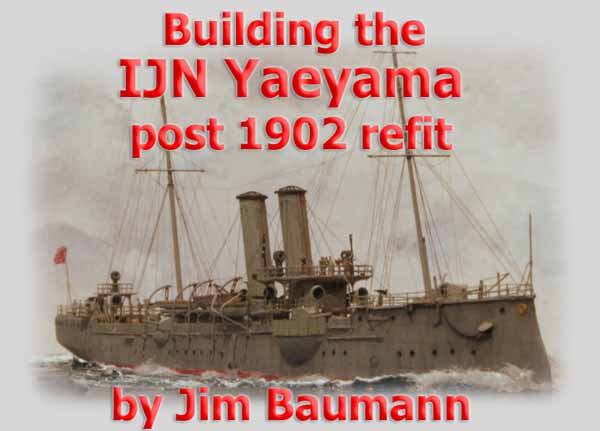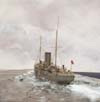 |
|||||||||||||||||||||||||||||||||||||
| Named after the Yaeyama Islands, southernmost of
the Okinawa archipelago, IJN Yaeyama was an un- protected cruiser of the
Imperial Japanese Navy, laid down in 1887 and completed in 1890. She was
designed under the supervision of the eminent and at the time influential
French designer Emile Bertin.
Light displacement coupled with powerful machinery resulted in an impressive speed of nearly 21 knots, making this lightly armoured and armed vessel ideal for the despatch and scouting duties for which she was often used. In the first Sino-Japanese war, 1894-1895, she protected Troop transports
to Korea and covered the landings of the Japanese army at Port Arthur.
The onset of wireless communications rendered the despatch vessel obsolete,
and she was stricken in 1906.
|
|||||||||||||||||||||||||||||||||||||
| Building the Model | |||||||||||||||||||||||||||||||||||||
| Yaeyama was an early release from Polish resin kit manufacturer
Modelkrak, alas like many of their older offerings which were based on
decidedly flawed and simplified drawings, the hull casting of Yaeyama
whilst dimensionally correct had a number of issues which would need
addressing to produce a satisfactory model.
Despite this I had always been drawn to the handsome sleek outline and chunky overhanging counter stern…. There is not a great deal of information and precious few photos of
this vessel; an appeal for assistance in the Modelwarships.com forum brought
a response from Japan with two superb images in very high resolution, albeit
at two distinctly different stages of the ships career.
It also meant that I would be able to verifiably correct the hull’s two biggest problems; the lack of sheerline and the incorrectly flared full bow. But first I had to remove the massive overpour of resin below the waterline
|
 |
||||||||||||||||||||||||||||||||||||
| The aforementioned photos of the real ship showed
the bow to have been like a sharp knifeblade; the kit item
was stumpy, rounded and flared out towards the deck.
A significant amount of resin would need to be removed before I could start reshaping the stem and cutwater |
 |
||||||||||||||||||||||||||||||||||||
 |
|||||||||||||||||||||||||||||||||||||
| Once the bow had been carved to shape I needed to address the lack
of sheer forward; I added tapered shims of styrene sheet, with the hull
suitably warmed on a radiator I was able to persuade the hull to
flex sufficiently with pressure applied centrally to take the
shape of sheerline as interpreted from the photos.
I drilled holes in the underside of the model amidships, thereby I was able to pull the hull down to the stainless steel base- plate and thereby re-induce the shape created. |
 |
||||||||||||||||||||||||||||||||||||
| The square scuttles aft…. whilst their positions agreed with the aforementioned
flawed drawing, were far too low down when compared to photos of the real
ship.
Re-cutting these retrospectively was unlikely to be successful without
cutting open the casting and slices of styrene and inserting shims.
The deck edge aft had a rolled edge; this was pared into shape before any further work was done. After her 1902 refit Yaeyama received an additional pair of 3 in guns
in openbacked shielded mounts carried on a small sponsons aft of midships.
|
 |
||||||||||||||||||||||||||||||||||||
| Most of the minor deck details were now removed to be later be replaced with scratched or PE items, deck houses were shortened and had overhanging roofs added from styrene sheet, numerous cowl vents were made and new funnels were made of Aluminium tubing. These were cut with a tube cutter, after which the base and tops were sanded in a jig to the correct angle of rake. |  |
||||||||||||||||||||||||||||||||||||
| After a brushed coat of hull colour paint showed up small fissures and where additional sanding was needed, the distinctive rubbing strakes were added of brass wire. |  |
||||||||||||||||||||||||||||||||||||
 |
|||||||||||||||||||||||||||||||||||||
| The previously drilled screwholes which I would eventually use to draw the model down to its desired sheerline on the steel baseplate using screws, now had two screws inserted part of the way in; I attached a powerful spingloaded clamp to these protruding screws, this facilitated the easy handling of this diminutive model during the detailing and final painting stage. |  |
||||||||||||||||||||||||||||||||||||
| Photos of the real ship showed the resin bride deck to be totally incorrect in plan shape and size; further, after the refit the wheelhouse roof had extended wings fitted to match the lower bridge. New items were made of Evergreen planked styrene sheet along with a new wheelhous. |  |
||||||||||||||||||||||||||||||||||||
| After most of the painting had been completed, the stainless steel base plate was prepared with its watercolor paper, the methodology of which I have described here: |  |
||||||||||||||||||||||||||||||||||||
| The model was now mounted so as to prevent delicate detail being distorted
or forced off as the hull was pulled down with the screws to the correct
sheerline.
The aft searchlight platform was scratchbuilt; the curved gusset supports of thin copper wire being particularly delicate. The slight distortion in the railing (visible in the photo) was cured after installation to the ships deck into pre-drilled small holes. |
 |
||||||||||||||||||||||||||||||||||||
| Skylights and boiler room hatches were added of PE
ladder stock, QF gun platforms were made of CA infused paper, boat
supports made of copper wire, cowl and mushroom vents were added along
with tapered gash shutes to the side of the hull.
The model now being mounted on its base made it far less vulnerable to accidental damage by my clumsy large hands! |
 |
||||||||||||||||||||||||||||||||||||
 |
|||||||||||||||||||||||||||||||||||||
| Most of the fine detailing is scratchbuilt; such as the
Semaphores on the upper bridge, davits were formed of brass wire, most
of the boats were changed in length and shape to suit—oars were made of
brown stretched sprue with the ends flattened with pliers, hawse holes
were reinforced with a paper ‘plate’, Admiralty type stocked anchors were
made of wire and white glue with paper flukes.
Cable reels were adapted from the fine Voyager PE items. Masts were made of tapered stainless steel, the drop down armour plates
for the fwd Gun sponsons were made of shortened WEM Askold PE items.
The funnels had steam pipes which had the standoff’s made of a drop of thinned white glue, which gave a very credible result, with a tiny visible gap. The funnel caps were made of stainless steel washers, topped with a copper rings and the steps being in-filled with white glue. |
 |
||||||||||||||||||||||||||||||||||||
 |
|||||||||||||||||||||||||||||||||||||
| Thereafter the model was rigged in my usual manner using
black and brown stretched sprue, the method being described here:
The sea colour was intended to be a rich dark blue, knocked back with a light grey wash and subsequently sealed with Glossy varnish. Finished model photos:
|
|||||||||||||||||||||||||||||||||||||
| All in all a satisfactory end result; a charming little
model of a relatively obscure vessel.
My thanks go to all my e-model friends around the world who assisted with images and advice! |
|||||||||||||||||||||||||||||||||||||




















